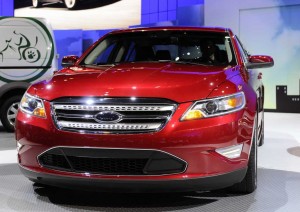
Sho-off: with the addition of an Ecoboost V-6, expect the 2010 Ford Taurus SHO to be one of the fastest offerings in its segment.
Ford Motor Company is betting big on its new Ecoboost engine, planning to offer variants of the high-mileage engine in 90% of its global vehicle lines, company officials reveal.
The first version of Ecoboost, a twin-turbocharged V-6, will make its debut, later this year, on four high-profile products: the Ford Flex, the new high-performance Taurus SHO, and the Lincoln MKS sedan and MKT crossover. The following year, Ford will add the 3.5-liter V-6 as an option on its big F-Series pickups. And confirming long-standing expectations, Ford officials confirm that a 4-cylinder version of the high-mileage engine will appear in the relatively near future.
 While Ford is expanding its line-up of hybrid-electric vehicles, and developing new plug-in hybrid-electric vehicles, or HEVs, and battery-electric vehicles, “Ecoboost is the foundation of our gasoline technology” going forward, explains Barb Samardzich, Ford’s Vice President of Powertrain Development.
While Ford is expanding its line-up of hybrid-electric vehicles, and developing new plug-in hybrid-electric vehicles, or HEVs, and battery-electric vehicles, “Ecoboost is the foundation of our gasoline technology” going forward, explains Barb Samardzich, Ford’s Vice President of Powertrain Development.
For the 2010 Calendar-Year, Samardzich noted, Ecoboost will be offered in 23% of Ford’s many models. By 2013, that will jump to 90%. Buyers will typically have other options – in products like Flex and the MKS, the Ecoboost will be the high-line option, and carry a still-unspecified price premium. But going forward, the I-4 version could become the mainstay in high-mileage Ford products. As a result, the automaker expects to sell 1.3 million vehicles equipped with the technology, in 2013, nearly half of those in the U.S.
At its most basic, the V-6 version of Ecoboost starts out with the same 3.5-liter block as is used in a wide range of current Ford products. But the rest of the powertrain package undergoes significant modifications. The technology borrows many of the features that have helped make today’s diesels much more appealing than in the past, such as high-pressure direct injection and intercooled turbocharging. In this case, twin turbos.
That permits Ford engineers to pump a hefty 355 horsepower and 350 foot-pounds of torque out of the Ecoboost V-6, a marked improvement from the standard version of the 3.5-liter engine, even though fuel economy is expected to run about 20% better.
That means “the customer doesn’t have to make a choice between performance and fuel economy,” adds Samardzich.
What’s particularly appealing is that Ecoboost is expected to deliver maximum torque from almost the moment the wheels start turning, yet there is reportedly little to no turbo lag, the annoying hesitation, associated with many turbocharged powertrains, when the driver first applies the throttle.
How much of a premium Ford plans to charge for an Ecoboost V-6, the company isn’t yet saying, though Kapp suggests the engine will achieve “payback,” or save as much in fuel as a motorist pays for the premium package “in less than two years.” Based on that assumption, a price tag of around $500 to $750 would seem likely. By comparison, it can take 5 to 10 years to achieve payback with a hybrid, and even longer with a diesel.
Notably, Ecoboost can run on regular grade fuel, though for heavy load applications, such as towing, Ford will recommend premium.
Ford is billing the V-6 Ecoboost as the alternative to a traditional V-8, the I-4 version as a substitute for a conventional V-6. Downsizing is an effective way to reduce fuel consumption, but the automaker claims the Ecoboost system does that without sacrificing performance – and, where appropriate, towing capacity. In the future, even the smallest cars could take advantage of the concept, replacing a modest 1.4-liter inline-four engine, for example, with a 1.0-liter Ecoboost.
There are numerous additional applications under study, according to Don Kapp, Ford’s Director of Research and Advanced Engineering. The Ecoboost engine could be paired with the electric powertrain technology of a hybrid to yield even better fuel economy than current HEVs.

So much for the $500 to $750 figure. For the V6, Ford is charging $3,000 in the Flex and $4,500 in the MKS.
Comparisons that equalize other features can be run here:
http://www.truedelta.com/prices.php